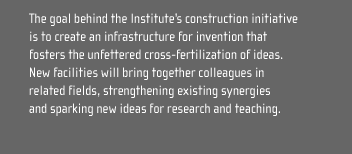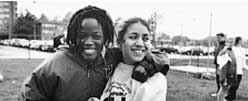
 |
|
 |


|
|
|
|
"The significant problems we face," Einstein once observed, "cannot be solved at the same level of thinking we were at when we created them." That philosophy is at the root of MIT's present building initiative. The Institute recognizes that, as one of the world's preeminent problem solvers, it must perpetually reinvent itself. The architectural metamorphosis now under way will add nearly one million state-of-the-art square feet to the 154-acre campus and will rejuvenate many existing facilities. New leading-edge laboratories will support emerging research demands. New residence halls and common spaces will inspire visionary collaborations. And the architecture itself will reinforce the vital, forward-thinking spirit of the community it serves. Each new building and renovation will give faculty, students, and staff greater resources to help shape the future. In the Media Lab's addition, researchers will explore new frontiers in information and learning technologies; while in the updated laboratories of the Dreyfus Chemistry Building, scientists will pursue advances in chemical synthesis. In laboratories and classrooms, coffee shops and dorm rooms all over the Institute, pioneers will launch new ideas in art and architecture, media and medicine, physics and pharmaceuticals, ethics and economics. The vision guiding the Institute's construction program is the creation of an infrastructure for invention that fosters the unfettered cross-fertilization of ideas. New facilities like the Stata Center and the Sloan School addition will bring together colleagues in related fields, strengthening existing synergies and sparking new ideas for research and teaching. MIT's Green Building Task Force has embraced the opportunity of the campus building boom to develop long-term goals to reduce the environmental impact of the campus. The Task Force expects to produce a quantitative model for evaluating building design in light of each environmental goal. The model will balance initial capital investment, life cycle cost, and impact on the environment. The Task Force has devised an interim guidance standard for projects yet to be designed. The evolving MIT campus will be both environmentally "green" and verdantly green with several landscaping projects underway. Walkways and common spaces are being redesigned to unify the campus physically, aesthetically, and socially, and significant works of art are being commissioned for many of the new buildings. In short, the Institute is striving to build a campus that will be a source of inspiration and support for the 17,000 members of the MIT community for generations to come. |
|
|
|
|
|
|
|
|
|